论文英文摘要要求与格式(免费)
- 格式:ppt
- 大小:157.00 KB
- 文档页数:63
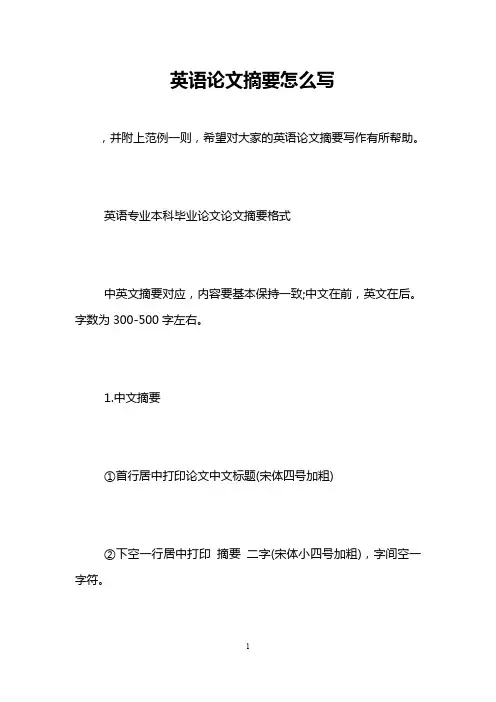
英语论文摘要怎么写,并附上范例一则,希望对大家的英语论文摘要写作有所帮助。
英语专业本科毕业论文论文摘要格式中英文摘要对应,内容要基本保持一致;中文在前,英文在后。
字数为300-500字左右。
1.中文摘要①首行居中打印论文中文标题(宋体四号加粗)②下空一行居中打印摘要二字(宋体小四号加粗),字间空一字符。
③摘要二字下空一行打印摘要内容(宋体小四号)。
④摘要内容后下空一行打印关键词三字(宋体小四号加粗),其后接着打印关键词(3-7个,宋体小四号),各关键词之间用逗号隔开,最后一个关键词后不打标点符号。
2.英文摘要①首行居中打印论文英文标题(Times New Roman四号加粗)②下空一行居中打印英文单词Abstract (Times New Roman 小四号加粗)。
③下空一行打印摘要内容(Times New Roman小四,1.5倍行距,两端对齐)④摘要内容后下空一行打印Key Words ( Times New Roman 小四号加粗),其后接着打印关键词(3-7个关键词,Times New Roman小四号)。
除了专有名词外,其他单词的首字母不大写。
各关键词之间用分号隔开,最后一个关键词后不打标点符号。
⑤摘要正文各自然段首行空5个字符。
Self-Knowledge of Emma(空1行)Abstract(空1行)Emma lives in a quite simple environment. When she is a little child, her mother dies and she is spoiled by her father. Having such a background, Emma is dominant, aggressive and imaginative. After she experiences the two major affairs in her life----the relationship with Harriet and her emotion towards Mr. Knightley, she realizes her own faults and acquires self-knowledge of both moral faults and emotion.After Emma fails to be a match-maker of Harriet and Mr. Knightley, she comes to know that feelings can not be imagined and that she should not force her own idea on others mind. And this is the very beginning of Emma s self-knowledge.(空1行)Key Words: Emma; characters; match-making; self-knowledge范例:A Brief Discussion on Cultural Difference between Chinese and EnglishAbstractWord is the product of society,which is the history of mankind and which is the crystallization of history and culture.It embodied a nation's social consciousness from generation to generation, history, culture, and other areas all the features of human society. The essence of which is dependent because of their different cultural background, language background and traditional factors above. chinese and english are quite different.such as mode of living,values,atandard of behavior,formality,customs. Language is is both the carrier and the product of culture, the cultural enrichment of information is an important part ofculture, Language reflects the culture of development and changes, but also a direct reflection of the cultural differences.As we all know china and english has different cultural atmosphere .china has a long history and rich culture. English in the contemporary world political, economic, cultural and other fields to play with temporary no other language can replace the role of English in a number of countries in addition to the mother tongue but also as a second language or foreign language in common use in many countries. As a symbol system, English is a kind of language, on their use, in today's world there are all sorts of English and English is in fact the name of a simple terms, we can not hope that justice Literal It is a single, homogeneous phenomenon it is all around the world and under different circumstances the use of the many variants of the English pool. However, due to geographical, historical, cultural, and social customs of different factors such as the impact of today's visit to English furniture has evolved into a wider impact on the two variants of the worldwide English, which is British English and American English. With the development of their own language, their own characteristics of the formation, and there are differences between. In American English and British English, is concernedabout the characteristics of the norms word. In this paper, the British and American English in origin and development of a simple introduction, the United Kingdom and the United States in terms of language study and to explore differences in the two English-speaking characteristics and differences, the right to express and enrich the relevant knowledge of English, improve application English ability.Key word: dependent; culture; atmosphere中西方文化差异摘要词是社会的的结晶,是人类历史和文化的结晶。
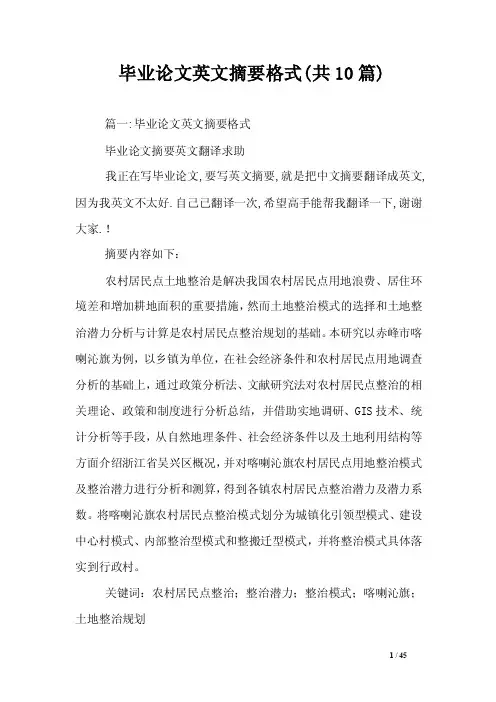
毕业论文英文摘要格式(共10篇)篇一:毕业论文英文摘要格式毕业论文摘要英文翻译求助我正在写毕业论文,要写英文摘要,就是把中文摘要翻译成英文,因为我英文不太好.自己已翻译一次,希望高手能帮我翻译一下,谢谢大家.!摘要内容如下:农村居民点土地整治是解决我国农村居民点用地浪费、居住环境差和增加耕地面积的重要措施,然而土地整治模式的选择和土地整治潜力分析与计算是农村居民点整治规划的基础。
本研究以赤峰市喀喇沁旗为例,以乡镇为单位,在社会经济条件和农村居民点用地调查分析的基础上,通过政策分析法、文献研究法对农村居民点整治的相关理论、政策和制度进行分析总结,并借助实地调研、GIS技术、统计分析等手段,从自然地理条件、社会经济条件以及土地利用结构等方面介绍浙江省吴兴区概况,并对喀喇沁旗农村居民点用地整治模式及整治潜力进行分析和测算,得到各镇农村居民点整治潜力及潜力系数。
将喀喇沁旗农村居民点整治模式划分为城镇化引领型模式、建设中心村模式、内部整治型模式和整搬迁型模式,并将整治模式具体落实到行政村。
关键词:农村居民点整治;整治潜力;整治模式;喀喇沁旗;土地整治规划翻译软件翻出来的你也要啊?Ruralresidentiallandreclamationistosolvethewasteofruralresidentialland,poorlivingenvironmentandtheimportantmeasurestoincrease theareaof cultivated land,butland management modechoiceandland reclamation potential analysis and calculation isthe foundation oftherural residential renovation plan.This studyinchifengcity kaLaQinQi, for example,inthevillages and towns,inthesocialand economicconditions andrural residential land,onthebasisof investigation and analysis, throughpolicy analysis, literature researchonrural residential renovation relatedtheory,policyandsystem analysis,andwiththeaidofon-the-spot investigation, statistical analysisandGIS,fromthenatural geographical conditions, socialeconomic conditions andlanduse structure in zhejiang province were introduced fromthe aspects suchasWuXing area,andthe kaLaQinQipatternsofruralresidentiallandregulationandcontrolpotential analysisandcalculation,fortownsofrural settlements renovation potentialandpotential coefficient.WillkaLaQinQiruralresidentialrenovationmodeisdividedintothemodelofurbanizationleadZhongXincunmode,constructiontype,。
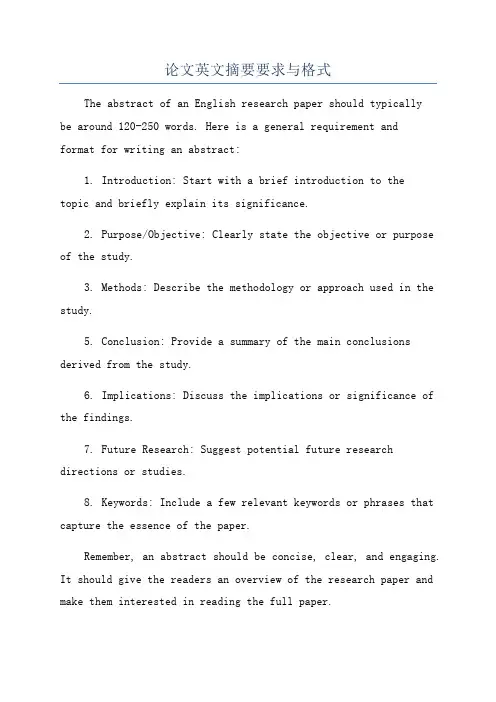
论文英文摘要要求与格式The abstract of an English research paper should typicallybe around 120-250 words. Here is a general requirement andformat for writing an abstract:1. Introduction: Start with a brief introduction to thetopic and briefly explain its significance.2. Purpose/Objective: Clearly state the objective or purpose of the study.3. Methods: Describe the methodology or approach used in the study.5. Conclusion: Provide a summary of the main conclusions derived from the study.6. Implications: Discuss the implications or significance of the findings.7. Future Research: Suggest potential future research directions or studies.8. Keywords: Include a few relevant keywords or phrases that capture the essence of the paper.Remember, an abstract should be concise, clear, and engaging. It should give the readers an overview of the research paper and make them interested in reading the full paper.Note: The length of the abstract can vary depending on the requirements of the journal or conference where you plan to submit your paper. Some journals may specify a maximum word count, while others may have a minimum and maximum word count range. Make sure to follow the specific guidelines provided by the target journal or conference.。
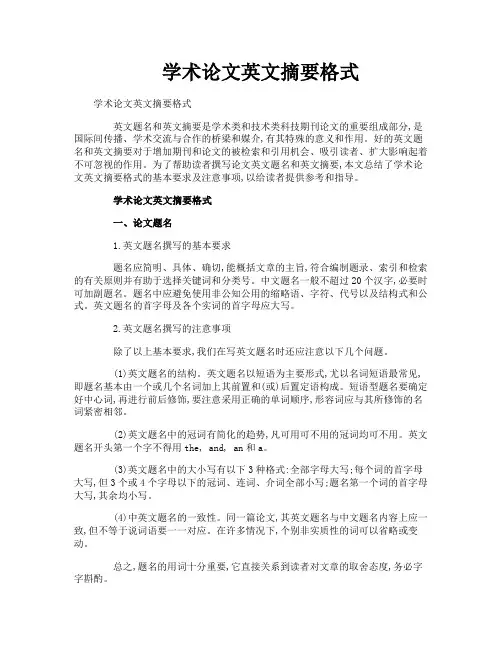
学术论文英文摘要格式学术论文英文摘要格式英文题名和英文摘要是学术类和技术类科技期刊论文的重要组成部分,是国际间传播、学术交流与合作的桥梁和媒介,有其特殊的意义和作用。
好的英文题名和英文摘要对于增加期刊和论文的被检索和引用机会、吸引读者、扩大影响起着不可忽视的作用。
为了帮助读者撰写论文英文题名和英文摘要,本文总结了学术论文英文摘要格式的基本要求及注意事项,以给读者提供参考和指导。
学术论文英文摘要格式一、论文题名1.英文题名撰写的基本要求题名应简明、具体、确切,能概括文章的主旨,符合编制题录、索引和检索的有关原则并有助于选择关键词和分类号。
中文题名一般不超过20个汉字,必要时可加副题名。
题名中应避免使用非公知公用的缩略语、字符、代号以及结构式和公式。
英文题名的首字母及各个实词的首字母应大写。
2.英文题名撰写的注意事项除了以上基本要求,我们在写英文题名时还应注意以下几个问题。
(1)英文题名的结构。
英文题名以短语为主要形式,尤以名词短语最常见,即题名基本由一个或几个名词加上其前置和(或)后置定语构成。
短语型题名要确定好中心词,再进行前后修饰,要注意采用正确的单词顺序,形容词应与其所修饰的名词紧密相邻。
(2)英文题名中的冠词有简化的趋势,凡可用可不用的冠词均可不用。
英文题名开头第一个字不得用the, and, an和a。
(3)英文题名中的大小写有以下3种格式:全部字母大写;每个词的首字母大写,但3个或4个字母以下的冠词、连词、介词全部小写;题名第一个词的首字母大写,其余均小写。
(4)中英文题名的一致性。
同一篇论文,其英文题名与中文题名内容上应一致,但不等于说词语要一一对应。
在许多情况下,个别非实质性的词可以省略或变动。
总之,题名的用词十分重要,它直接关系到读者对文章的取舍态度,务必字字斟酌。
二、论文摘要1.摘要的定义摘要又称概要、内容提要。
摘要是论文主体的高度浓缩,它应该能提炼论文的主要观点,简明地描述论文的内容和范围,简短地进行概括和总结。
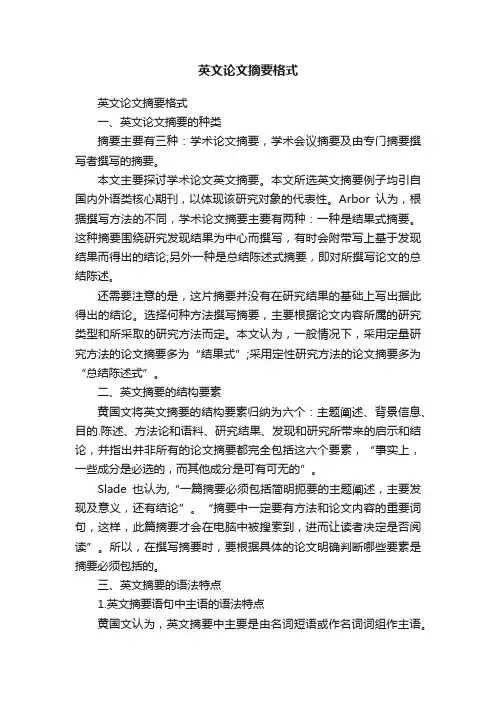
英文论文摘要格式英文论文摘要格式一、英文论文摘要的种类摘要主要有三种:学术论文摘要,学术会议摘要及由专门摘要撰写者撰写的摘要。
本文主要探讨学术论文英文摘要。
本文所选英文摘要例子均引自国内外语类核心期刊,以体现该研究对象的代表性。
Arbor认为,根据撰写方法的不同,学术论文摘要主要有两种:一种是结果式摘要。
这种摘要围绕研究发现结果为中心而撰写,有时会附带写上基于发现结果而得出的结论;另外一种是总结陈述式摘要,即对所撰写论文的总结陈述。
还需要注意的是,这片摘要并没有在研究结果的基础上写出据此得出的结论。
选择何种方法撰写摘要,主要根据论文内容所属的研究类型和所采取的研究方法而定。
本文认为,一般情况下,采用定量研究方法的论文摘要多为“结果式”;采用定性研究方法的论文摘要多为“总结陈述式”。
二、英文摘要的结构要素黄国文将英文摘要的结构要素归纳为六个:主题阐述、背景信息、目的.陈述、方法论和语料、研究结果、发现和研究所带来的启示和结论,并指出并非所有的论文摘要都完全包括这六个要素,“事实上,一些成分是必选的,而其他成分是可有可无的”。
Slade也认为,“一篇摘要必须包括简明扼要的主题阐述,主要发现及意义,还有结论”。
“摘要中一定要有方法和论文内容的重要词句,这样,此篇摘要才会在电脑中被搜索到,进而让读者决定是否阅读”。
所以,在撰写摘要时,要根据具体的论文明确判断哪些要素是摘要必须包括的。
三、英文摘要的语法特点1.英文摘要语句中主语的语法特点黄国文认为,英文摘要中主要是由名词短语或作名词词组作主语。
但本文所引实例可以使我们更具体的发现,充当主语的通常为非人的名词短语或名词词组。
被动语态也在适当的时候出现,这些特点都表明摘要写作要遵循客观性这一道理。
表明论文的研究不是作者的主观想象,而是通过大量的科学研究而的得出的结论。
2.英文摘要的时态特点时态上,摘要也具有其自身的特点。
Arbor认为,表示总结的语句通常与一般现在时或现在完成时;表示结果的语句可用过去时。
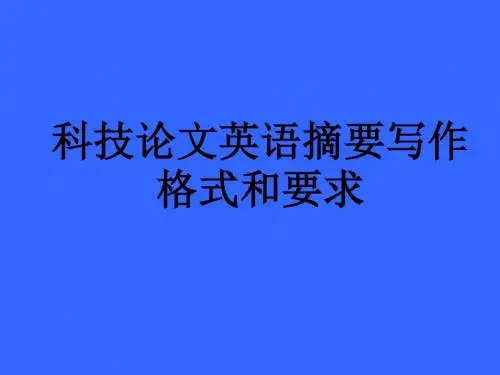
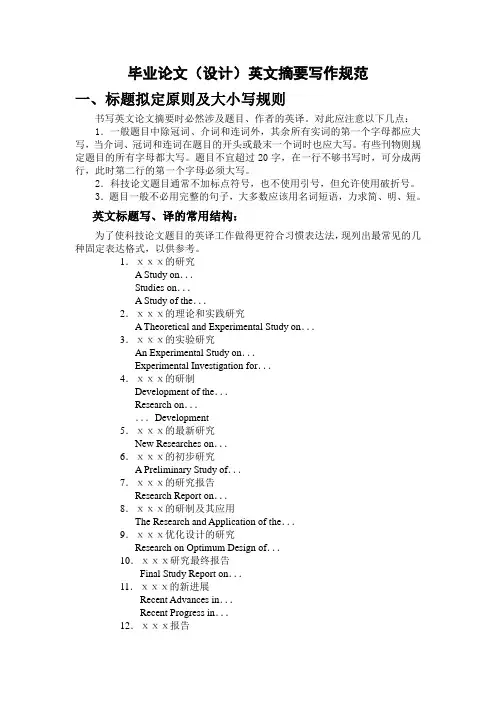
毕业论文(设计)英文摘要写作规范一、标题拟定原则及大小写规则书写英文论文摘要时必然涉及题目、作者的英译。
对此应注意以下几点:1.一般题目中除冠词、介词和连词外,其余所有实词的第一个字母都应大写,当介词、冠词和连词在题目的开头或最末一个词时也应大写。
有些刊物则规定题目的所有字母都大写。
题目不宜超过20字,在一行不够书写时,可分成两行,此时第二行的第一个字母必须大写。
2.科技论文题目通常不加标点符号,也不使用引号,但允许使用破折号。
3.题目一般不必用完整的句子,大多数应该用名词短语,力求简、明、短。
英文标题写、译的常用结构:为了使科技论文题目的英译工作做得更符合习惯表达法,现列出最常见的几种固定表达格式,以供参考。
1.ⅹⅹⅹ的研究A Study on...Studies on...A Study of the...2.ⅹⅹⅹ的理论和实践研究A Theoretical and Experimental Study on...3.ⅹⅹⅹ的实验研究An Experimental Study on...Experimental Investigation for...4.ⅹⅹⅹ的研制Development of the...Research on......Development5.ⅹⅹⅹ的最新研究New Researches on...6.ⅹⅹⅹ的初步研究A Preliminary Study of...7.ⅹⅹⅹ的研究报告Research Report on...8.ⅹⅹⅹ的研制及其应用The Research and Application of the...9.ⅹⅹⅹ优化设计的研究Research on Optimum Design of...10.ⅹⅹⅹ研究最终报告Final Study Report on...11.ⅹⅹⅹ的新进展Recent Advances in...Recent Progress in...12.ⅹⅹⅹ报告A Report of...13.ⅹⅹⅹ方法Methods of...14.ⅹⅹⅹ计算方法A Computational Method for...15.ⅹⅹⅹ的简化计算方法A Simplified Method of Calculation of...16.ⅹⅹⅹ的一个简化方法A Simplified Method for...17.ⅹⅹⅹ的一般分析法A General Analytic Method of...18.ⅹⅹⅹ方法的改进An Improvement on the Method of..19.ⅹⅹⅹ的计算Calculation for...20.ⅹⅹⅹ的理论计算A Theoretical Calculation of...21.ⅹⅹⅹ近似计算The Approximate Calculation of...22.ⅹⅹⅹ分析An Analysis of...23.ⅹⅹⅹ的分析与计算Analysis and Calculation of...24.ⅹⅹⅹ探讨Exploration on...A Study of...Study on...Investigation on...Approach to...Research on...Discussion on...25.ⅹⅹⅹ的理论探讨A Research on the Theory of...26.ⅹⅹⅹ应用The Application of...The Application of...to...An Application of...The Use of...27.ⅹⅹⅹ及其应用...and Its Application...and Their Application28.ⅹⅹⅹ方法及其应用Method of...and Its Application 29.ⅹⅹⅹ对ⅹⅹⅹ的影响The Effect of ...on ...30.ⅹⅹⅹ的影响Influence of ...Influence on ...31.ⅹⅹⅹ的几个问题Some Problems of ...32.ⅹⅹⅹ的几个重要问题Some Important Problems in ...33.ⅹⅹⅹ的特性Characteristics of ...34.ⅹⅹⅹ的性能比较A Performance Comparison of ...35.ⅹⅹⅹ研制,性能评定和验证Development,Performance Assessment and Verification of ...36.ⅹⅹⅹ误差分析和实验验证The Error Analysis and Experimental Verification for ...37.ⅹⅹⅹ的设计与实现Design and Implementation of ...38.ⅹⅹⅹ的优化设计Optimization Design of ...Optimum Design of ...39.ⅹⅹⅹ的合理化设计The Rationalized Design of ...40.ⅹⅹⅹ的分析与改进Analysis and Improvement of ...41.ⅹⅹⅹ的可靠性分析Reliability Analysis of ...42.ⅹⅹⅹ的测量与分析The Measurement and Analysis of ...43.ⅹⅹⅹ自动测试系统The Automatic Test System of ...44.ⅹⅹⅹ的误差分析Error Analysis of ...45.ⅹⅹⅹ的实验Experiments on ...Test of ...46.ⅹⅹⅹ的实验测定Experimental Determination of ...47.ⅹⅹⅹ破坏性实验研究Destructive Test Study of ...48.ⅹⅹⅹ的性能评定Evaluation of ...49.ⅹⅹⅹ的性能Performance of ...50.ⅹⅹⅹ的实验研究Experimental Study for ...51.ⅹⅹⅹ的设计与研制Design and Development for ...52.ⅹⅹⅹ的设计标准...A Design Criteria for ...53.ⅹⅹⅹ的精密测量High Precision Measurement of ...54.ⅹⅹⅹ的方法和仪器Method and Apparatus for ...55.ⅹⅹⅹ的应用技术Applied Technology of ...56.ⅹⅹⅹ方案A Scheme of ...57.ⅹⅹⅹ的实用方案A Practical Scheme of ...58.ⅹⅹⅹ建议A Suggestion on ...59.ⅹⅹⅹ的若干建议Some Recommendations for ...60.ⅹⅹⅹ小结A Preliminary Summary of ...A Preliminary Report on ...A Brief Report of ...61.ⅹⅹⅹ的调查A Survey of ...62.ⅹⅹⅹ的回顾与进展A Review and Prospect of ...63.ⅹⅹⅹ目前和今后的发展趋势Present and Future Trends in ...64.ⅹⅹⅹ的述评Some Comments on ...65.评“ⅹⅹⅹ”Some Comments on ...66.ⅹⅹⅹ的注记A Note on ...67.ⅹⅹⅹ商榷A Discussion on ...68.ⅹⅹⅹ简介A Brief Description of ...69.论ⅹⅹⅹOn ...70.关于ⅹⅹⅹA Discussion on ...科技论文标题范例:1.A Study on Silurian Tempestites in Tazhong Area,Tarim Basin 塔中地区志留系风暴沉积2.Organic Geochemical Characteristics of Ordovician Car-Bonate Rocks in the Middle and Western Ordos鄂尔多斯盆地中西部地区奥陶系碳酸盐有机地球化学特征3.A History of Two-phase-filling of Crude Oil in the Upper Reservoir of Well Leng 118辽河油田冷118井上部油藏原油两期注入史4.On Relations Between Signal-to-noise Ratio and Fractional Dimension of Seismic Data地震数据信噪比与分数维的关系探讨5.Viscous Fingering in Self-affine Sierpinski Carpet自仿射Sierpinski地毯中的粘滞指进一、人名拼音书写规范作者姓名是学术期刊中的重要数据之一,它在目次页、正文、作者简介和参考文献等多处出现。
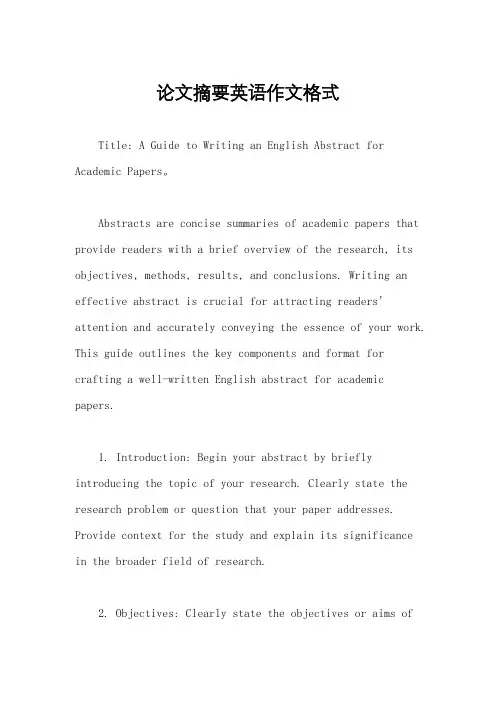
论文摘要英语作文格式Title: A Guide to Writing an English Abstract for Academic Papers。
Abstracts are concise summaries of academic papers that provide readers with a brief overview of the research, its objectives, methods, results, and conclusions. Writing an effective abstract is crucial for attracting readers' attention and accurately conveying the essence of your work. This guide outlines the key components and format for crafting a well-written English abstract for academic papers.1. Introduction: Begin your abstract by briefly introducing the topic of your research. Clearly state the research problem or question that your paper addresses. Provide context for the study and explain its significancein the broader field of research.2. Objectives: Clearly state the objectives or aims ofyour study. What are you trying to achieve with your research? Identify the specific goals that guided your investigation and motivated your study.3. Methods: Describe the methods or methodologies used in your research. Provide a concise overview of the research design, data collection procedures, and analytical techniques employed in your study. Highlight any innovative or unique aspects of your methodology.4. Results: Summarize the key findings of your study. Present the most important results or outcomes of your research in a clear and concise manner. Avoid interpreting the results in the abstract; instead, focus on presenting the facts objectively.5. Conclusions: Conclude your abstract by summarizing the main conclusions or implications of your research. Discuss the significance of your findings and how they contribute to the existing body of knowledge in the field. Highlight any theoretical or practical implications of your study.6. Keywords: Include a list of keywords or phrases that accurately represent the content of your paper. Choose terms that are relevant to your research topic and are commonly used in the field. Keywords facilitate indexing and help readers locate your paper in databases and search engines.7. Formatting: Follow the formatting guidelines specified by the journal or conference where you intend to submit your paper. Typically, abstracts are single-spaced and range from 150 to 300 words in length. Use clear and concise language, avoiding unnecessary technical jargon or acronyms.8. Revision and Proofreading: After drafting your abstract, carefully review and revise it to ensure clarity, accuracy, and coherence. Check for grammar, spelling, and punctuation errors. Consider seeking feedback from colleagues or mentors to improve the quality of your abstract.In conclusion, writing an effective abstract requires careful attention to detail and adherence to the conventions of academic writing. By following the guidelines outlined in this guide, you can craft a clear, informative, and compelling abstract that effectively communicates the essence of your research to your audience.。
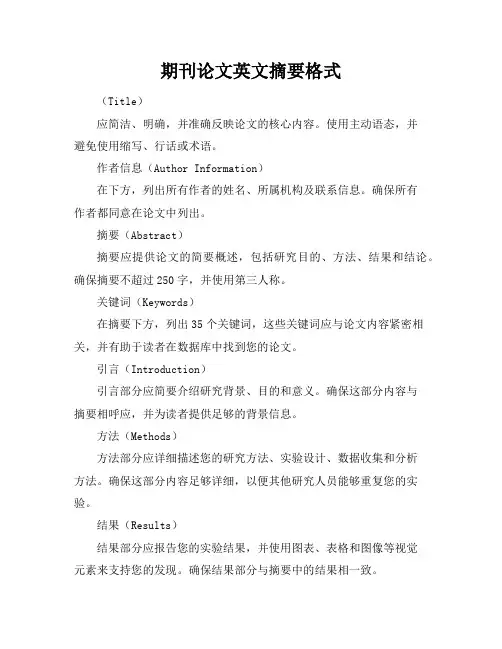
期刊论文英文摘要格式(Title)应简洁、明确,并准确反映论文的核心内容。
使用主动语态,并避免使用缩写、行话或术语。
作者信息(Author Information)在下方,列出所有作者的姓名、所属机构及联系信息。
确保所有作者都同意在论文中列出。
摘要(Abstract)摘要应提供论文的简要概述,包括研究目的、方法、结果和结论。
确保摘要不超过250字,并使用第三人称。
关键词(Keywords)在摘要下方,列出35个关键词,这些关键词应与论文内容紧密相关,并有助于读者在数据库中找到您的论文。
引言(Introduction)引言部分应简要介绍研究背景、目的和意义。
确保这部分内容与摘要相呼应,并为读者提供足够的背景信息。
方法(Methods)方法部分应详细描述您的研究方法、实验设计、数据收集和分析方法。
确保这部分内容足够详细,以便其他研究人员能够重复您的实验。
结果(Results)结果部分应报告您的实验结果,并使用图表、表格和图像等视觉元素来支持您的发现。
确保结果部分与摘要中的结果相一致。
讨论(Discussion)讨论部分应解释您的研究结果,并将其与现有文献进行比较。
确保这部分内容深入分析结果,并指出研究的局限性和未来研究方向。
结论(Conclusion)致谢(Acknowledgments)附录(Appendices)在致谢下方,提供任何额外的材料,如原始数据、代码或额外的图表。
确保附录部分与内容相一致。
期刊论文英文摘要格式(Title)是论文的“门面”,应简洁明了,直接反映论文的核心内容。
避免使用缩写、行话或术语,以便所有读者都能理解。
通常使用主动语态,这样可以更直接地传达信息。
作者信息(Author Information)在下方,列出所有作者的姓名、所属机构及联系信息。
确保所有作者都同意在论文中列出,并且按照贡献大小排序。
联系信息应包括电子邮件地址,以便读者与作者联系。
摘要(Abstract)摘要应提供论文的简要概述,包括研究目的、方法、结果和结论。
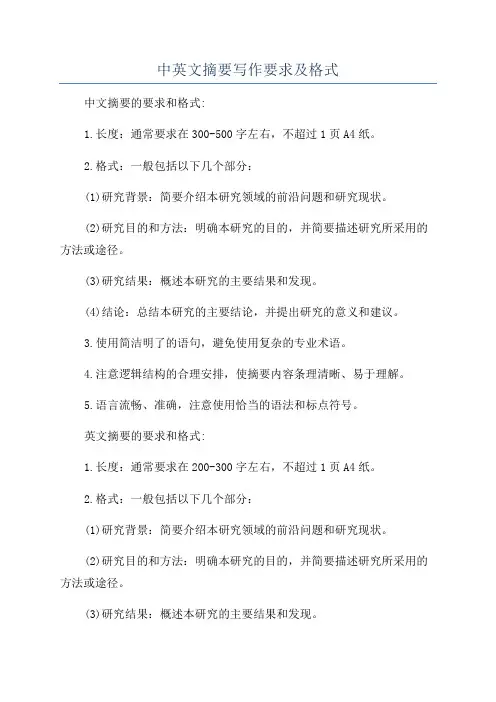
中英文摘要写作要求及格式
中文摘要的要求和格式:
1.长度:通常要求在300-500字左右,不超过1页A4纸。
2.格式:一般包括以下几个部分:
(1)研究背景:简要介绍本研究领域的前沿问题和研究现状。
(2)研究目的和方法:明确本研究的目的,并简要描述研究所采用的方法或途径。
(3)研究结果:概述本研究的主要结果和发现。
(4)结论:总结本研究的主要结论,并提出研究的意义和建议。
3.使用简洁明了的语句,避免使用复杂的专业术语。
4.注意逻辑结构的合理安排,使摘要内容条理清晰、易于理解。
5.语言流畅、准确,注意使用恰当的语法和标点符号。
英文摘要的要求和格式:
1.长度:通常要求在200-300字左右,不超过1页A4纸。
2.格式:一般包括以下几个部分:
(1)研究背景:简要介绍本研究领域的前沿问题和研究现状。
(2)研究目的和方法:明确本研究的目的,并简要描述研究所采用的方法或途径。
(3)研究结果:概述本研究的主要结果和发现。
(4)结论:总结本研究的主要结论,并提出研究的意义和建议。
3.使用简洁明了的语句,避免使用复杂的专业术语。
4.注意逻辑结构的合理安排,使摘要内容条理清晰、易于理解。
5.注意语法、拼写和标点符号的准确使用。
6.根据期刊或会议的要求,可能需要在摘要中提供一定的关键词。
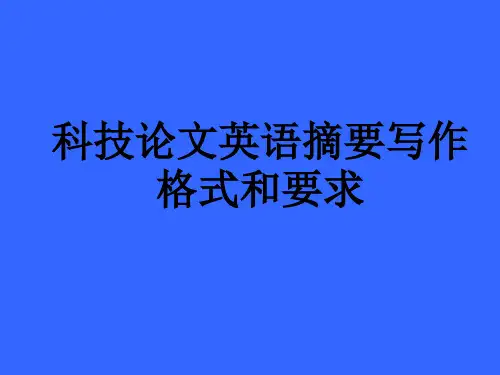
英文摘要的写作规范英文摘要的写作规范本文是英语论文写作指导,本次主要是针对英语论文摘要要怎么写,以及英文摘要的具体写作规范进行详细指导,供参考。
英文摘要的写作规范【1】1、英语摘要是应用符合英文语法的文字语言,以提供论文内容梗概为目的,不加评论和补充解释,简明、确切地阐述论文重要内容的短文。
2、英文摘要必须符合“拥有与论文同等量的主要信息”的原则。
为此,英文摘要应重点包括4个要素,即研究目的、方法、结果、结论。
在这4个要素中,后2个是最重要的。
在执行上述原则时,有些情况下,英文摘要可包括研究工作的主要对象和范围,以及具有情报价值的其它重要的信息。
3、英文摘要句型力求简单,通常有10个意义完整语句顺畅的句子。
4、英文摘要不应有引言中出现的内容,也不要对论文内容作诠释和评论,不得简单重复题名中已有的信息;不用非公知公用的符号和术语,不用引文,除非该论文证实或否定了他人已发表的论文,缩略语、略称、代号,除了相邻专业的读者也能清楚理解的以外,在首次出现时必须加以说明;科技论文写作时应注意的其他事项,如采用法定计量单位,正确使用语言文字和标点符号等,也同样适用于英文摘用的编写。
英语论文摘要怎么写【2】英语论文摘要英语论文摘要又称文摘,是论文的重要组成部分,它是以提供文献内容梗概为日的,不加评论和补充解释,简明、确切地记述文献重要内容的短文。
摘要应具有独立性和自明性,并拥有与文献同等量的主要信息,即不需阅读全文,就可获得重要的信息。
摘要通常置于文题之后,文章之首。
在论文发表后,论文摘要常被文献检索系统所收集。
英语论文摘要一般为200-300单词,并有与英文摘要表达观点一致的中文摘要与之对应。
英语论文分类英语论文一般分为外语翻译、语言文化、英美文学、英语相关四大类撰写方法完成毕业论文的撰写可以分两个步骤,即选择课题和研究课题。
首先是选择课题。
选题是论文撰写成败的关键。
要选择有科学价值和现实意义的、切实可行的课题。
中英文详细摘要格式要求
中英文详细摘要(500字左右,不超过IoOO字)采用统一封面。
论文题目下空一行居中打印“摘要”二字(黑体小二号加粗),“摘要” 二字下空一行打印摘要内容(宋体小四号)。
摘要内容后下空一行打印“关键词”三字(黑体小四号),其后为关键词(宋体小四号)。
关键词数量为3〜5个,每一关键词之间用分号分开,最后一个关键词后不打标点符号。
英文摘要应与中文摘要保持内容一致。
“ABSTRACT” ( Times New Roman字体小二号)9再下空一行打印英文摘要内容(TimeS New Roman 字体小四号)。
摘要内容后下空一行打印“KEYWORDS:”,用TimeSNeWROman字体小四号加粗,其后关键词小写(第一个字母大写),关键词数量为3〜5个,每一关键词之间用分号分开,最后一个关键词后不打标点符号,Times New Roman字体四号。
中文摘要的页眉打印,无论一级标题在奇数页还是偶数页都不显示页眉;其余页奇数页为“摘要”,偶数页为“沈阳理工大学硕士学位论文”;英文摘要的页眉打印,无论一级标题在奇数页还是偶数页都不显示页眉;其余页奇数页为“Abstract” ,偶数页为“沈阳理工大学硕士学位论文” o 中英文摘要单面打印,加页码,居中。
中、英文摘要写作要求及格式1.摘要写作要求摘要的内容要包括研究的目的、方法、结果和结论。
计量单位一律换算成国际标准计量单位。
除特殊情况外,数字一律用阿拉伯数字。
中、英文摘要的内容应严格一致。
2.中文摘要中文摘要前打印毕业论文(毕业设计)的标题。
主标题一般不超过20个汉字。
如有副标题,应另起一行(副标题前加破折号),副标题(包括破折号在内)同样不得超过20个汉字。
中文主标题格式:可选用本模板中的样式所定义的“论文中文主标题”,或手动设置(黑体,三号,居中,段前1行、段后0行,单倍行距)。
中文副标题格式:可选用本模板中的样式所定义的“论文中文副标题”,或手动设置(楷体_GB2312,四号,居中,段前0.5行,段后0行,单倍行距)。
中文标题下空一行为摘要。
“摘要:”格式:首行缩进2字符,黑体,小四。
“摘要:”后紧接摘要正文。
字数在200字左右。
中文摘要正文格式:可选用本模板中的样式所定义的“中文摘要正文”,或手动设置(楷体_GB2312,小四,行距为固定值20磅)。
中文摘要正文后空一行,另起一行列出3-5个关键词。
“关键词:”格式:首行缩进2字符,黑体,小四。
“关键词:”后紧接关键词。
关键词之间用分号间隔,最后一个关键词末尾不加标点。
中文关键词格式:楷体_GB2312,小四,行距为固定值20磅。
3.英文摘要中文关键词下空两行打印毕业论文(毕业设计)的英文标题。
英文主标题首字母大写,标题中其他单词实词首字母大写,其他均为小写。
英文主标题格式:可选用本模板中的样式所定义的“论文英文主标题”,或手动设置(Times New Roman,四号,加粗,居中,段前段后均为0行,单倍行距)。
英文副标题格式:可选用本模板中的样式所定义的“论文英文副标题”,或手动设置(Times New Roman,小四,加粗,居中,段前0.5行,段后0行,单倍行距)。
英文标题下空一行为英文摘要。
“Abstract:”格式:首行缩进2字符,Times New Roman,小四,加粗。
毕业论文英文摘要格式毕业论文英文摘要格式一篇论文的摘要在本质上就是一篇浓缩的论文,它是作者对研究过程、研究目的、研究方法和研究结果的简要陈述和概括,其结构与论文的主体结构相对应。
格式:Abstract(“Abstract”一词用Times New Roman字体三号,加黑,居中。
)Thought of people as the center is the marrow of ourtraditional culture and the core of the theory of managing stateaffairs.It germinates in the early state of antiquity society and is based on patriarchal clan system.It is also a kind of value seeking for the realization of the ethic reason and moral justice.Its basic thinking is that the monarch is defined by people and conversely people are defined by the monarch. At first appearance, its purpose is to value people’s suffering, fate and interest on theruler’s position.However, its real intention is to fool the people soas to strengthen and co nsolidate the ruler’s rule.The theory of “people-oriented concept” includes nine topics such as “the theory of people is being the root of the monarch’s rule”, “the theory of people is being more valuable than the monarch”, “the theory of the monarch is being people’s servant” and so on.People –oriented means “value the people ” in essence, which sees “people” as its foundation of politics rule, ranking official,and administration.(正文字体为:Times New Roman字体,小四号,且行距为单倍或1.5倍。
毕业论文英文摘要范文关于《毕业论文英文摘要范文》,是我们特意为大家整理的,希望对大家有所帮助。
毕业论文是离不开摘要的,摘要又称概要、内容提要。
摘要是以提供文献内容梗概为目的,不加评论和补充解释,简明、确切地记述文献重要内容的短文。
一般我们都写得是中文摘要,那么英文摘要又怎么写呢?写英文摘要又需要注意什么问题呢?下面学术堂列举三篇毕业论文英文摘要范文,来向大家说明。
毕业论文英文摘要范文一:论文题目:On the Title of EST and Aesthetic Effect in Its TranslationAbstract: With the development of science and technology, translation of English of Science and Technology has become more and more important. A good title can help readers understand the main ideas about some articles of science and technology at the first step. And a good translation can also shows the artistic effect and the content of the translator. The author wants to offer all the translation learners some ways to attract more readers by researching the titles of EST and artistic effects of them in this essay.Key words: EST; title; translation; artistic effects毕业论文英文摘要范文二:论文题目:On Advertisement Translation from English to Chinese in Light of Functional EquivalenceAbstract:The theories which proposed by Eugene A. Nida have affected many Chinese and foreign translators for a long time, especially the theory of functional equivalence. Functional equivalence refers to the equivalence on the functions but not on the forms and structures.In our daily life, we live with different advertisements, some of which are translated works. These advertisements are aimed at giving the potential customers a lasting impression and persuading them to buy their product. Therefore, in order to express the ideas of the original works and realize the goal for sale, the translators should take account of the cultural elements and social elements in order to achieve functional equivalence.This paper consists of three parts. The first part deals with the concept of functional equivalence and its aims and principles. The main aim of functional equivalence is to represent the information of the original work in the target language and achieve the equivalence of functions of languages. In order to make this concept clear, the author gives a brief introduction of different functions. Although different languages have different characteristics, their functions are nearly the same. That is to name the reality and to communicate with the people. The second part deals with the target, principles, requirements and cultural elements of advertisement translation. The third part, the most important part, points out the three main aspects of functional equivalence, semantic equivalence, social-cultural equivalence and stylistic equivalence. At the meantime, the equivalence on different levels and how to achieve functional equivalence in advertisement translation are also systematically illustrated.Key words: functional equivalence; advertisement translation; cultural elements毕业论文英文摘要范文三:论文题目:On Cultural Gaps and Untranslatability in Chinese Version of The Life and Strange Surprizing Adventures of Robinson Crusoe from Perspective of FunctionalismAbstract:This thesis is an attempt to apply functionalism to literary translation and prove its feasibility by analyzing the untranslatability of the Adventures of Robinson Crusoe causing by cultural gaps. Functionalism is a broad term for various theories that approach translation by focusing on the function or functions of texts and translations. And the four important representatives of functionalism are Katharina Reiss, Hans J. Vermeer, Justa Holz-Mnttri and Christiane Nord. This thesis attempts to apply the core rules of Skopostheorie –?to analyze theuntranslatability of the Adventures of Robinson Crusoe which is caused by cultural gaps, in the hope of gaining a better understanding of literary translation from the perspective of functionalism.This paper is composed of four chapters. The first one is introduction. Chapter 2 introduces the German Functionalism and translation theories including a brief introduction to the Adventures of Robinson Crusoe and the author Defoe. Chapter 3 goes over the application of the main translation theory Skopostheorie in analyzing the untranslatability of the Adventures of Robinson Crusoe causing by cultural gaps with analyzing the culture factor in translation. Besides, this chapter also analyses the limitations of Skopostheorie. In chapter 4, the final conclusion is that functionalism is also applicable to literary translation and can provide a different perspective in solving the untranslatability causing by cultural gaps.Key Words: functionalism; skopostheorie; untranslatability; culture gaps; The Adventures of Robinson Crusoe。